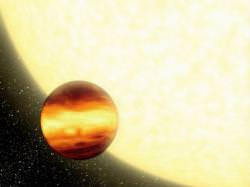 Think of the strongest wind you’ve ever experienced. No, think of the strongest wind anyone’s ever experienced. It still doesn’t hold a candle to the terrifyingly strong winds on some extrasolar planets. There are gas giants out there, with masses similar to Jupiter, that experience winds as strong as 14,400 kph (9,000 mph).
Think of the strongest wind you’ve ever experienced. No, think of the strongest wind anyone’s ever experienced. It still doesn’t hold a candle to the terrifyingly strong winds on some extrasolar planets. There are gas giants out there, with masses similar to Jupiter, that experience winds as strong as 14,400 kph (9,000 mph).
This seems to be the only way to explain measurements of three extrasolar planets that orbit extremely close to their parent stars. With one face to the star, you would think that half the planet is white hot, while the other is much cooler. But strangely, these planets have roughly the same temperature across the entire planet.
These supersonic winds move so quickly, they’re able to churn the planets’ atmospheres, and keep temperatures from dropping on the night side.
A team of American astronomers recently presented their findings at the American Astronomical Society’s annual meeting in Seattle, Washington. They used the Spitzer Space Telescope to measure the infrared light of the planets at eight different positions in their orbit in 2005. They measured the brightness when the planets were facing the Earth, and then when they were facing away. Amazingly, they found no variations.
The three planets are 51 Pegasi, about 50 light years from our sun, HD179949b about 100 light years distant, and HD209458b about 147 light years away.
